Essaouira is a small port town located on the Atlantic coast of Morocco. It is a popular tourist destination for its ancient architecture, friendly locals, and stunning beaches.
One of the most beautiful aspects of Essaouira is the abundance of birds that can be found in the area. From the coastal waters to the inland forests, Essaouira is home to a wide variety of bird species that make it a birdwatcher’s paradise.
The diversity and sheer number of birds in the area are truly remarkable, making it a great place to observe and appreciate the beauty of these amazing creatures.
1. Greater Flamingo
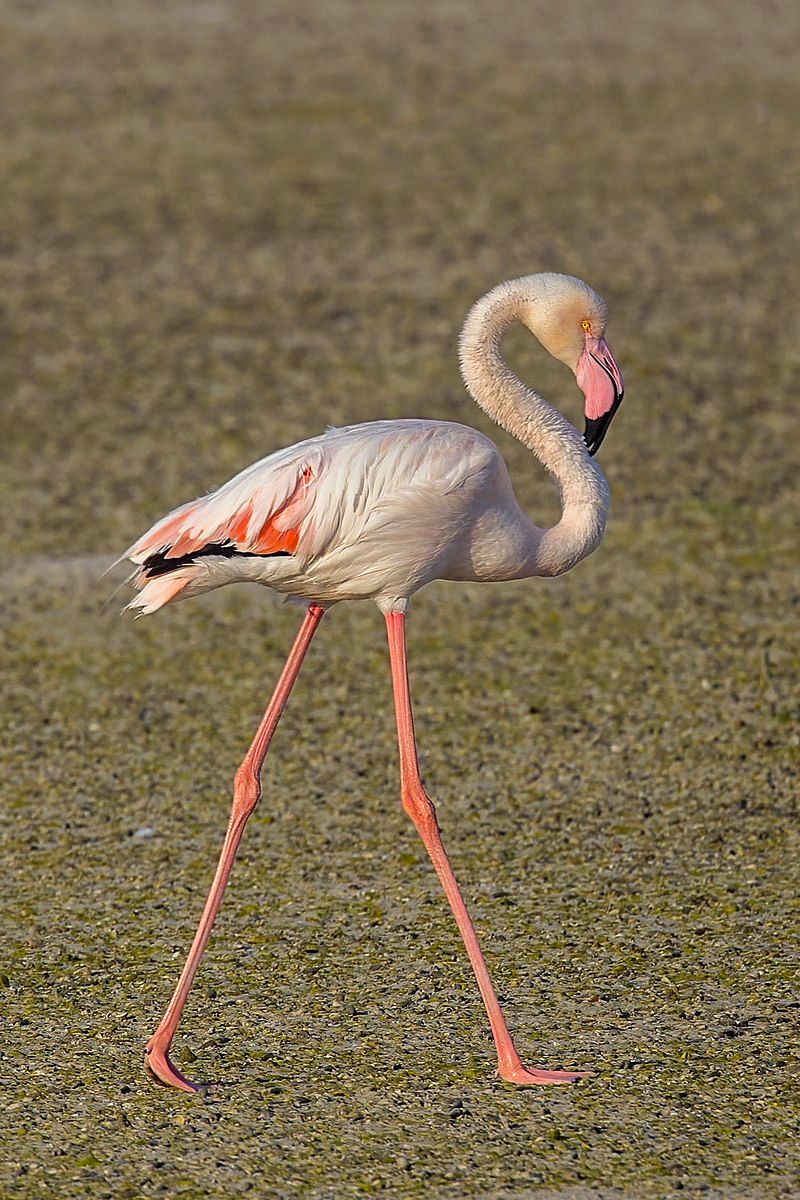
The greater flamingo is the largest and most widespread species of the flamingo family.
This species of bird is commonly found in the Old World, which includes Northern and Sub-Saharan Africa, the Indian Subcontinent, the Middle East, the Levant, the Persian Gulf, the Gulf of Aden, the Red Sea, and the Mediterranean countries of Southern Europe.
These birds tend to live in shallow lakes, rivers, lagoons, and marshes throughout these regions. The greater flamingo has a long neck and long, stick-like legs, with pink feathers on the body and wings. They can reach up to 5 feet tall and weigh up to 8 pounds.
They have a curved beak and a distinct red patch on the face. The greater flamingo is a social species and usually forms large flocks in their natural habitats. They feed mainly on small crustaceans, aquatic invertebrates, and algae.
They filter their food from the water using their curved beaks.
They also consume small amounts of plant matter, such as seeds and grains. The greater flamingo is an important species in the ecosystems where they are found, as they help to maintain a healthy balance of the aquatic food webs.
They are also an important species for the tourist industry in some regions, as they attract people from around the world to observe them in their natural habitats.
| Kingdom | Animalia |
| Phylum | Chordata |
| Class | Aves |
| Order | Phoenicopteriformes |
| Family | Phoenicopteridae |
| Genus | Phoenicopterus |
| Species | P. roseus |
2. Laughing Dove
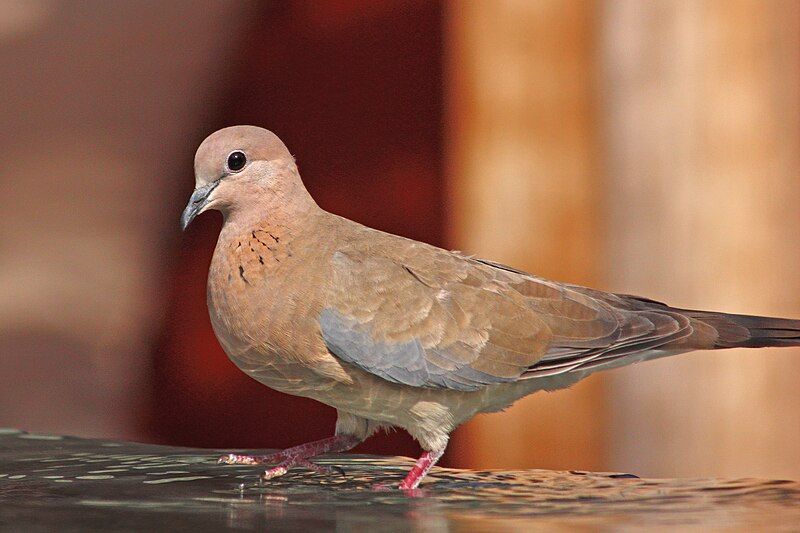
The laughing dove is a species of small pigeon native to Africa, the Middle East, South Asia, and Western Australia. It is a resident breeder, meaning that it stays in the same area all year round and does not migrate.
This species of pigeon has a distinct call that sounds like laughter, hence its name. The laughing dove has a long history in Western Australia, having been released from Perth Zoo in 1898.
Since then, it has established itself in the wild and become a common sight in the region. It is a resilient species that has adapted to urban and suburban areas and can often be seen in parks, gardens, and on the edges of agricultural fields.
The laughing dove is a beautiful and fascinating bird. Its plumage is a combination of browns, tans, and greys, with a distinctive black-and-white pattern on its wings. Its body is generally slender and long-tailed, and its head is usually a lighter shade than its body.
The laughing dove is a sociable bird that can often be seen in groups, either in flight or foraging for food on the ground. The laughing dove is a small pigeon that is a resident breeder in Africa, the Middle East, South Asia, and Western Australia.
Since its release from Perth Zoo in 1898, it has become a common sight in the region, adapting to both rural and urban environments. It is a beautiful and sociable bird, with its distinct call sounding like laughter.
| Kingdom | Animalia |
| Phylum | Chordata |
| Class | Aves |
| Order | Columbiformes |
| Family | Columbidae |
| Genus | Spilopelia |
| Species | S. senegalensis |
3. European Turtle Dove
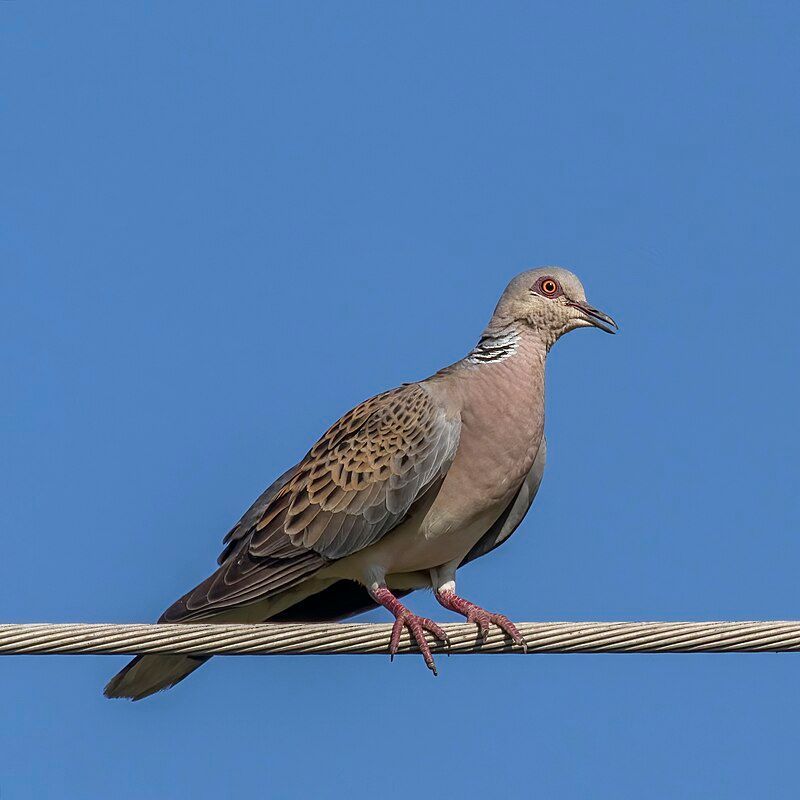
The European turtle dove is a species of bird that belongs to the Columbidae family, which encompasses doves and pigeons. This species is found across a vast range of the southwestern Palearctic, spanning from North Africa to parts of Europe.
During the winter months, it migrates southward to northern sub-Saharan Africa. This species is known for its migratory behavior across large distances, and its ability to survive in multiple habitats.
The habitat of the European turtle dove includes temperate woodlands, grasslands, and scrubland. They are social birds and live in flocks, and during the breeding season, they nest in tree hollows, shrubs, and even on the ground.
They feed on seeds, fruits, and invertebrates, and their diet shifts depending on the season and available food sources. The European turtle dove has seen a drastic decline in population in recent years due to a variety of factors.
These include habitat destruction from urbanization, changes in land use, and intensive agricultural practices. There is also a threat of predation and surveillance by humans.
As a result of these threats, the population of the European turtle dove has dramatically decreased in recent years, leading to an increased need for conservation efforts in order to protect this species.
| Kingdom | Animalia |
| Phylum | Chordata |
| Class | Aves |
| Order | Columbiformes |
| Family | Columbidae |
| Genus | Streptopelia |
| Species | S. turtur |
4. Common Pochard
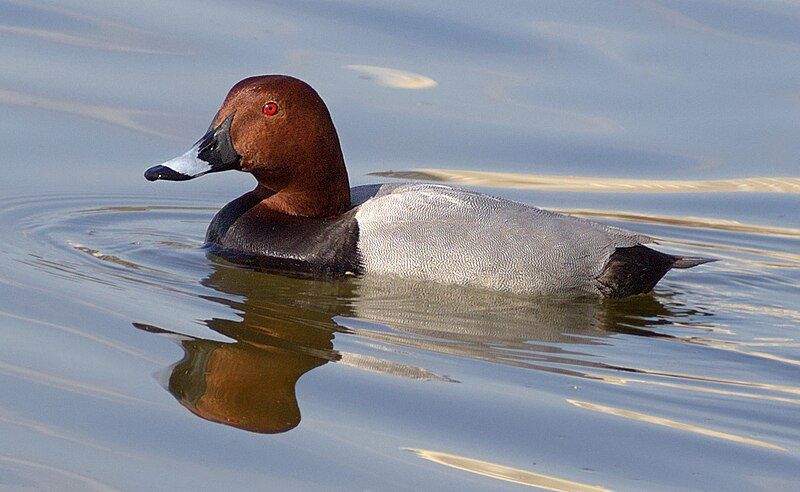
The common pochard is a species of diving duck that belongs to the family of Aythyidae. It is a medium-sized waterfowl, with a body length of 41-54 cm and a wingspan of up to 80 cm.
The scientific name of the common pochard is derived from the Greek word “aithuia” and the Latin word “ferina”. Aithuia is an unidentified seabird that was first mentioned by the Greek writers Hesychius and Aristotle.
The Latin word “ferina” is derived from “ferus” which means “wild”. This word refers to the wild nature of this species of duck, as it is often found in the wild and is not commonly domesticated. Thus, the scientific name of the common pochard reflects its wild, untamed nature.
| Kingdom | Animalia |
| Phylum | Chordata |
| Class | Aves |
| Order | Anseriformes |
| Family | Anatidae |
| Genus | Aythya |
| Species | A. ferina |
5. Great Spotted Cuckoo
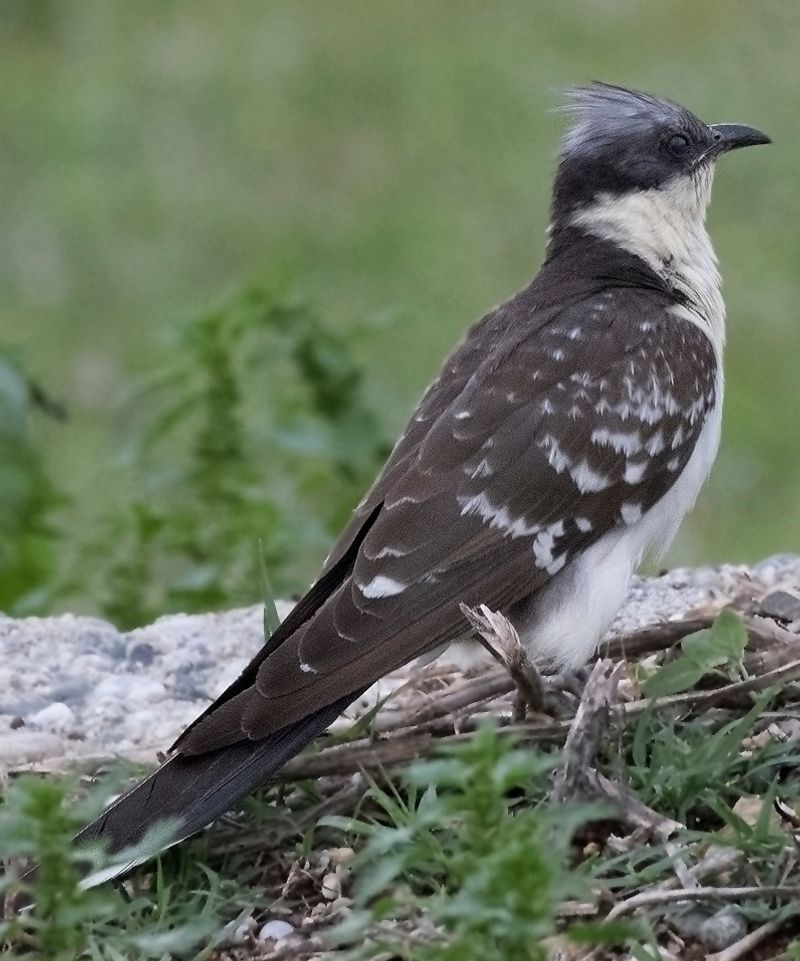
The great spotted cuckoo is a distinctive member of the Cuculiformes order of birds, a group that also includes the roadrunners, the anis, and the coucals.
It is widely distributed across Africa and the Mediterranean Basin and is easily identified by its brown and white-spotted plumage. The great spotted cuckoo is a brood parasite, meaning that it lays its eggs in other birds’ nests, specifically those of corvids like the Eurasian magpie.
This behavior allows the cuckoo to avoid taking on the task of feeding and raising it’s own young, instead relying on the host species to do the work for it.
The host species may not even realize that the cuckoo has laid eggs in its nest, and unknowingly raises the cuckoo chicks along with its own.
This behavior helps the great spotted cuckoo to survive in its environment, as it does not need to expend as much energy as it would if it had to raise its own chicks.
| Kingdom | Animalia |
| Phylum | Chordata |
| Class | Aves |
| Order | Cuculiformes |
| Family | Cuculidae |
| Genus | Clamator |
| Species | C. glandarius |
6. Red-necked Nightjar
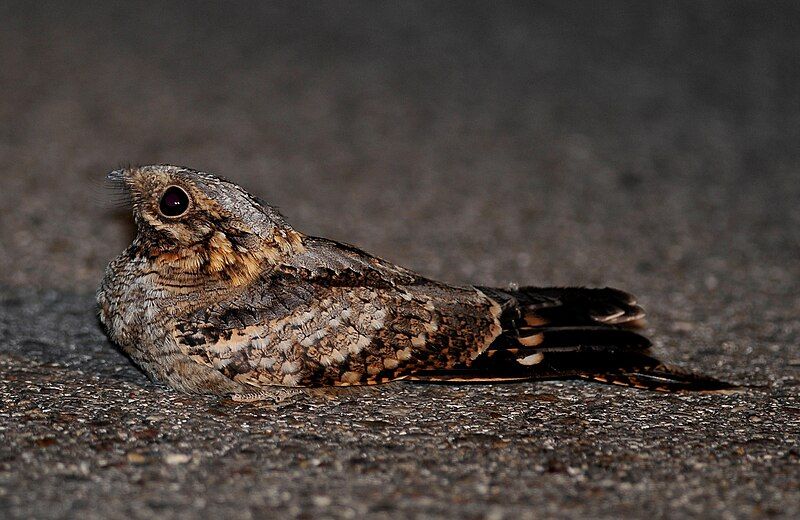
The red-necked nightjar is a species of bird that is found in Europe. It is the largest of the nightjars found in the region and breeds during the summer months in Iberia and North Africa.
During the winter months, the red-necked nightjar migrates to tropical West Africa, where it will spend the colder months. This species of bird is a nocturnal species, meaning that it is most active at night, and feeds mainly on insects.
It has a distinctive plumage, with reddish-brown feathers on the back and neck, and mottled grey and brown feathers on the wings and tail. The red-necked nightjar is an impressive bird to see in the wild and is an important part of Europe’s diverse avian population.
| Kingdom | Animalia |
| Phylum | Chordata |
| Class | Aves |
| Clade | Strisores |
| Order | Caprimulgiformes |
| Family | Caprimulgidae |
| Genus | Caprimulgus |
| Species | C. ruficollis |
7. Barbary Partridge
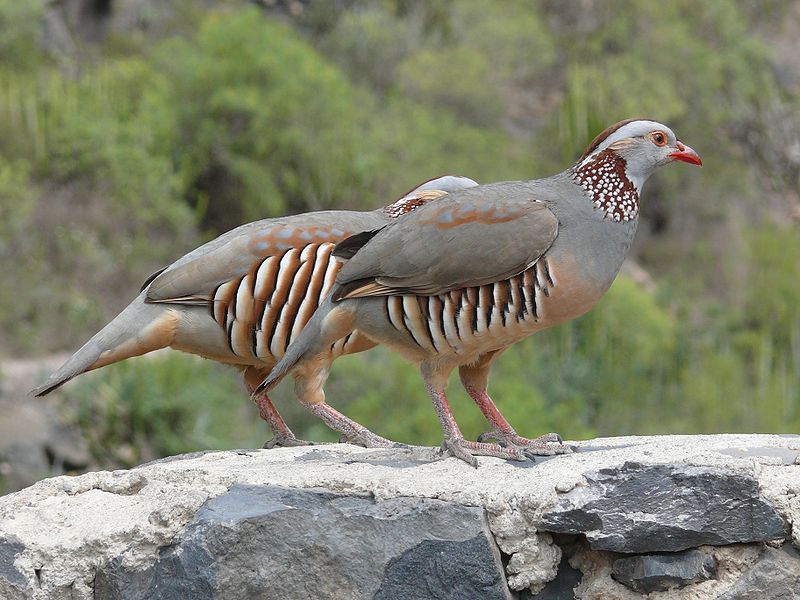
The Barbary partridge is a species of gamebird belonging to the Phasianidae family, which is part of the order Galliformes. It is native to the region of North Africa, specifically found in Algeria, Morocco, and Tunisia.
The bird is a medium-sized species, with males typically having a length of around 31 cm and females being somewhat smaller at a length of 27 cm. They are generally brownish in color, with males having a reddish head and throat and females having a grey head and throat.
The Barbary partridge is an omnivorous bird, mainly feeding on grains, seeds, and insects. They tend to live in scrubland and open woodlands, with some individuals inhabiting more urban areas such as parks and gardens.
The species is threatened by habitat loss due to agricultural development and hunting. Conservation efforts are underway to help preserve this species and its habitat.
| Kingdom | Animalia |
| Phylum | Chordata |
| Class | Aves |
| Order | Galliformes |
| Family | Phasianidae |
| Genus | Alectoris |
| Species | A. barbara |
8. Mallard
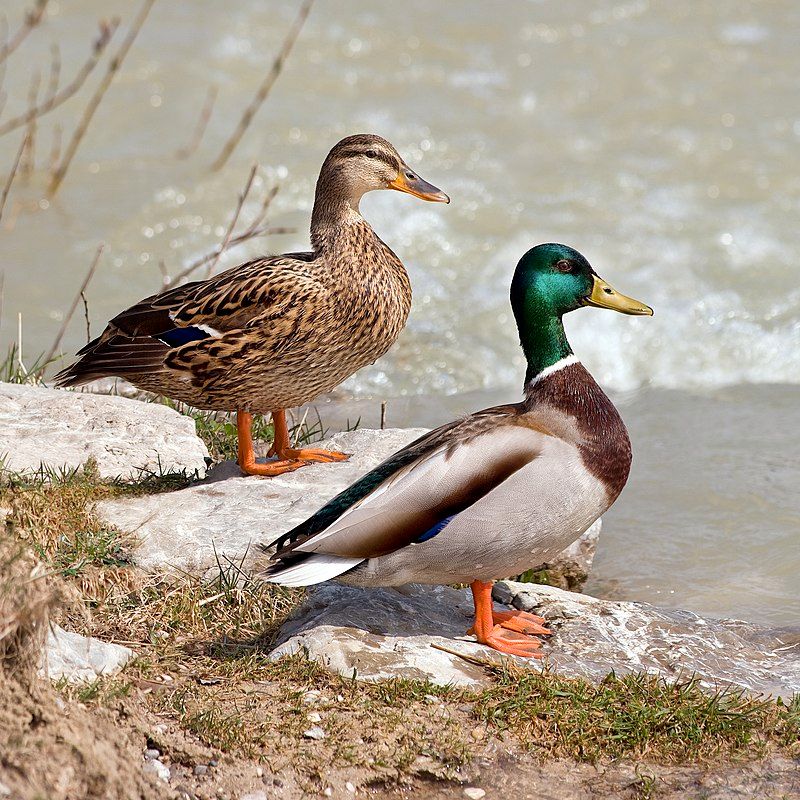
The mallard or wild duck is a species of dabbling duck that can be found in a variety of climates across the world. It is native to temperate and subtropical regions of the Americas, Eurasia, and North Africa.
In addition, it has been introduced to New Zealand, Australia, Peru, Brazil, Uruguay, Argentina, Chile, Colombia, the Falkland Islands, and South Africa. The mallard is a migratory species, meaning that when the climate of a region becomes too cold or dry, it will move to another area.
This high degree of adaptability has allowed the species to successfully colonize many different areas of the world. The mallard is a generalist species, meaning that it is able to feed on a variety of food sources such as insects, crustaceans, seeds, grains, and vegetation.
This wide range of diets makes them able to survive in a variety of habitats. The Mallard is also known to eat small fish and amphibians, which makes them an important predator in aquatic ecosystems. The mallard is a social species, often seen in large groups.
They are known to form strong pair bonds between males and females, with the male tending to the nest and offspring while the female forages for food.
This behavior helps to ensure the survival of the species in the wild. Overall, the mallard is a highly adaptable species that is able to survive in a variety of climates and habitats.
Its ability to survive in different environments has allowed it to colonize many parts of the world and become an important part of many ecosystems.
| Kingdom | Animalia |
| Phylum | Chordata |
| Class | Aves |
| Order | Anseriformes |
| Family | Anatidae |
| Genus | Anas |
| Species | A. platyrhynchos |
9. Marbled Teal
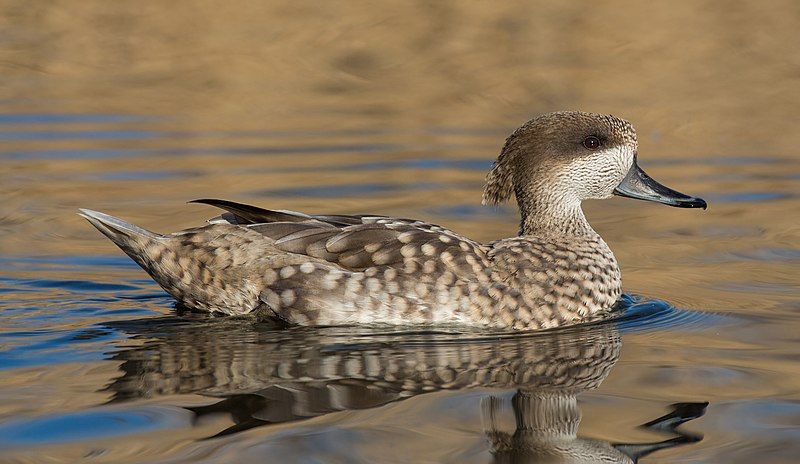
The Marbled Duck, also known as the Marbled Teal, is a species of duck found in a wide range of habitats, including southern Europe, northern Africa, and western and central Asia.
It is a medium-sized bird, with males reaching a length of up to 45 cm and females reaching a length of up to 42 cm.
The scientific name of the Marbled Duck, Marmaronetta angustirostris, is derived from the Greek marmaros, meaning “marbled,” and Netta, meaning “duck,” as well as the Latin angustus, meaning “narrow” or “small,” and rostris, meaning “billed.” This name is fitting, as the male Marbled Duck has a distinctive marbled pattern on its plumage, and its bill is slender and pointed.
The female Marbled Duck is a duller brown, with a shorter bill. This species of duck feeds on aquatic plants, invertebrates, and small vertebrates.
They typically inhabit wetlands, such as shallow lakes, marshes, or flooded pastures, where they can find plenty of food and shelter. The Marbled Duck is classified as Near Threatened by the IUCN, due to habitat destruction and hunting.
| Kingdom | Animalia |
| Phylum | Chordata |
| Class | Aves |
| Order | Anseriformes |
| Family | Anatidae |
| Genus | Marmaronetta |
| Species | M. angustirostris |
10. Northern Pintail
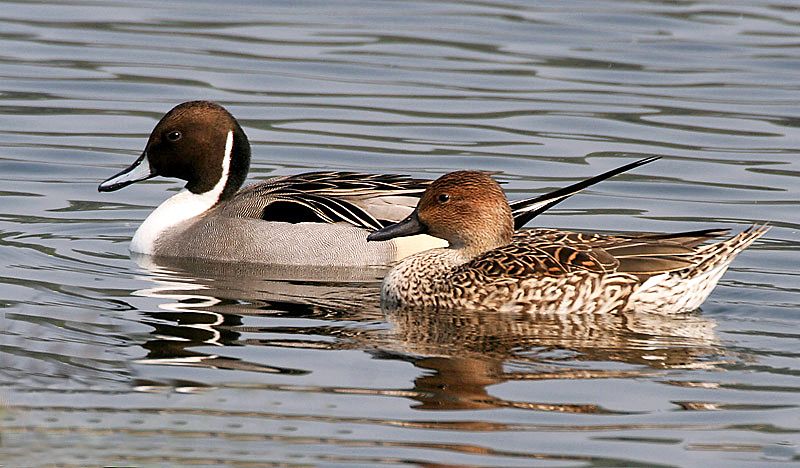
The pintail is a species of duck that has a wide geographic distribution. It breeds in northern Europe, the Palearctic, and North America. During the winter months, it migrates southward, away from its breeding range, and can be found as far south as the equator.
This indicates that the pintail is a hardy species, able to survive in a wide range of climates. The pintail is also a migratory bird. Its migratory behavior allows it to access different regions of the world during different times of the year.
This gives it access to more food sources and makes it less vulnerable to predators. The pintail is an important species ecologically. It is a top-level predator, preying on small animals such as insects, fish, and amphibians.
It also plays an important role in seed dispersal, helping to spread important species of vegetation throughout its range. In addition to its ecological importance, the pintail is also a popular game bird.
Hunters prize them for their size and speed, making them challenging and rewarding prey.
The pintail is also a popular subject of photography, with its distinctive shape and long, elegant neck making it a beautiful subject for any photographer. Overall, the pintail is an important species with a wide geographic distribution and wide-ranging ecological and cultural significance.
It is a species that should be protected and preserved so that future generations can continue to appreciate its beauty and importance.
| Kingdom | Animalia |
| Phylum | Chordata |
| Class | Aves |
| Order | Anseriformes |
| Family | Anatidae |
| Genus | Anas |
| Species | A. acuta |
11. Common Scoter
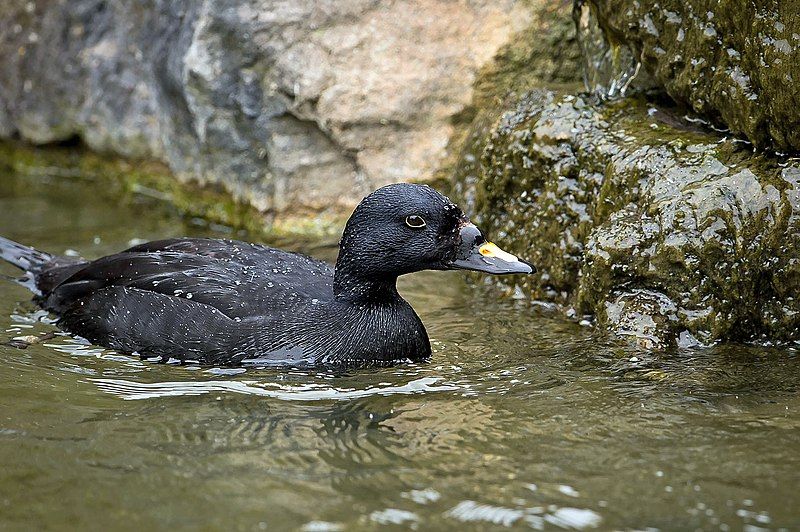
The Common Scoter is a large sea duck that can be found in various areas of Europe and the Palearctic region. It is 43-54 cm in length and is known for its black feathers.
The genus name for the common scoter is derived from two Ancient Greek words: melas, meaning “black”, and Netta, meaning “duck”. Similarly, the species name is derived from the Latin word niger, which is translated to “shining black”.
This is in reference to the bird’s black feathers, which are often seen to have a shiny quality to them.
| Kingdom | Animalia |
| Phylum | Chordata |
| Class | Aves |
| Order | Anseriformes |
| Family | Anatidae |
| Genus | Melanitta |
| Species | M. nigra |
12. Eurasian Teal
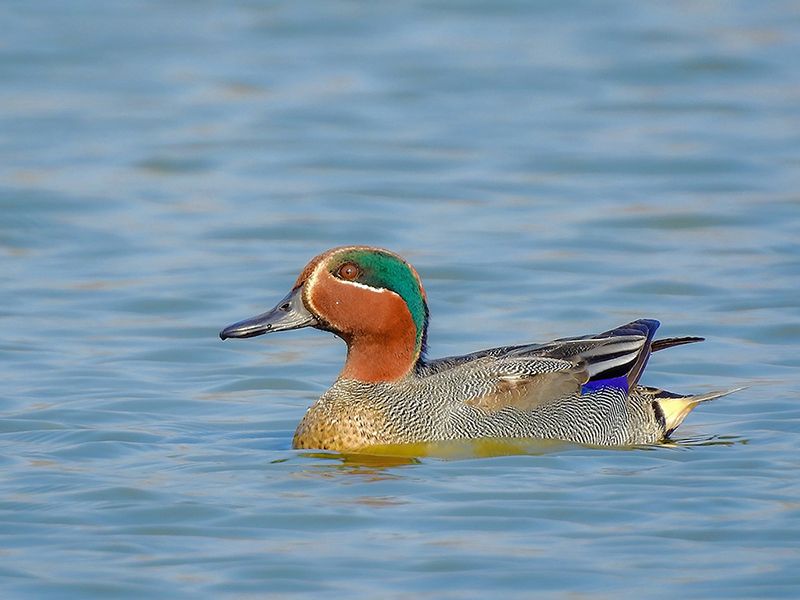
The Eurasian teal, also known as the common teal or Eurasian green-winged teal, is a species of duck that can be found in temperate regions of Eurosiberia. This duck is quite common and can be seen in many habitats, ranging from marshes and wetlands to grasslands and fields.
During the winter months, the Eurasian teal migrates south in search of a more suitable climate. This species of duck is often referred to simply as “teal” due to the fact that it is the only species of its kind in most of the areas it inhabits.
The Eurasian teal is renowned for its beautiful plumage, which includes green wings and a reddish-brown head. This species of duck is often seen in large flocks, and it is quite adept at dabbling in the water for food.
The Eurasian teal is also a popular game bird, as its meat is highly sought after by hunters.
| Kingdom | Animalia |
| Phylum | Chordata |
| Class | Aves |
| Order | Anseriformes |
| Family | Anatidae |
| Genus | Anas |
| Species | A. crecca |
13. Common Moorhen
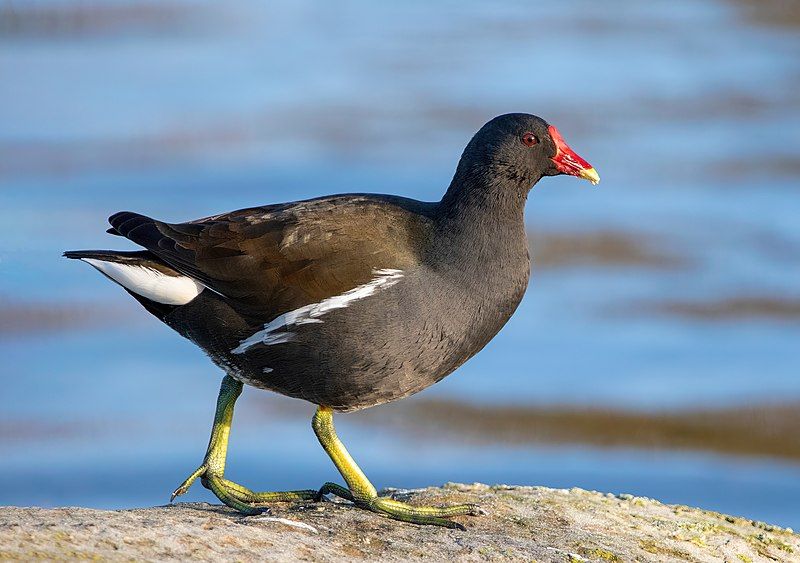
The common moorhen is a bird species that belongs to the rail family. It is native to many parts of the Old World and is found around well-vegetated wetlands, such as marshes, ponds, and canals. This bird is also known as the waterhen or swamp chicken.
The common moorhen is a medium-sized bird, with a body length between 28-35 cm and a wingspan of 50-60 cm. Its plumage is black, gray, or brown, with white bills, feet, and undertail coverts. It has a distinctive white stripe above its eye and a black band on its front.
The common moorhen feeds mainly on aquatic vegetation, but also eats small invertebrates and occasionally fish. It is a vocal bird, with its call being a loud ‘korr-korr-korr’ sound. It is also an excellent swimmer, using its long toes to propel itself through the water.
The common moorhen is an important species in its wetland habitats, as it helps to control aquatic vegetation and keeps the water clean. It is also an important food source for a variety of predators, including birds of prey, foxes, raccoons, and cats.
Overall, the common moorhen is an important species in its wetland habitats. It helps to keep its habitat healthy and is also an important food source for a variety of predators.
| Kingdom | Animalia |
| Phylum | Chordata |
| Class | Aves |
| Order | Gruiformes |
| Family | Rallidae |
| Genus | Gallinula |
| Species | G. chloropus |
14. Black-winged Stilt
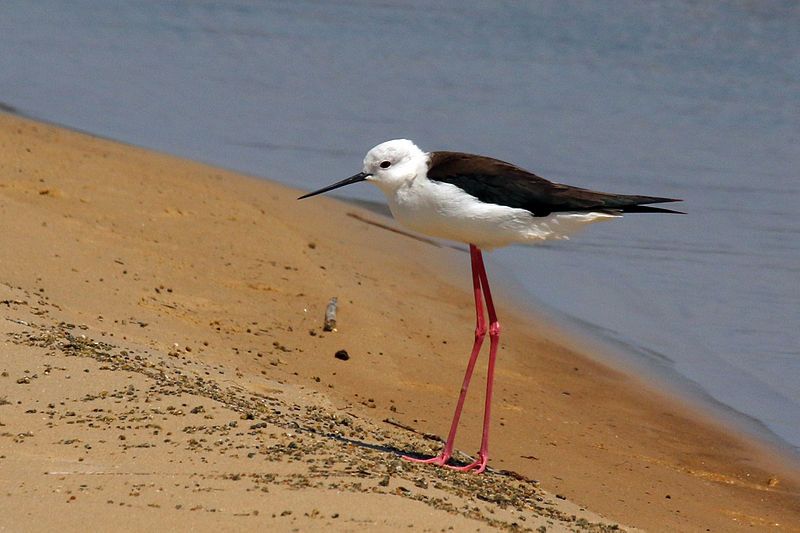
The black-winged stilt (Himantopus himantopus) is a species of wading bird in the avocet and stilt family. It is widely distributed across many continents and has very long legs. It is sometimes referred to by its scientific name, H.
himantopus, as it is the only species of stilt found throughout the world. The black-winged stilt has a black head, neck, and wings, and a white body with a black back. Their long, slender legs are usually pinkish in color.
It is a common species and can be found in shallow wetlands, mudflats, and other coastal habitats. It feeds mainly on aquatic insects, crustaceans, mollusks, and other small aquatic creatures. The black-winged stilt nests on the ground and lays three to four eggs.
The eggs are incubated by both parents for 21-28 days before hatching. The young are cared for by the parents for up to seven weeks.
It is a highly social species and often forms large flocks, especially during migration and winter. The black-winged stilt is a valuable species in its natural environment, as its diet helps to keep the aquatic ecosystems healthy and balanced.
They are also popular with birdwatchers and photographers, due to their striking appearance and unique behavior. Although its global population is currently stable, it is threatened by habitat destruction, pollution, and hunting in some areas.
| Kingdom | Animalia |
| Phylum | Chordata |
| Class | Aves |
| Order | Charadriiformes |
| Family | Recurvirostridae |
| Genus | Himantopus |
| Species | H. himantopus |
15. Tufted Duck
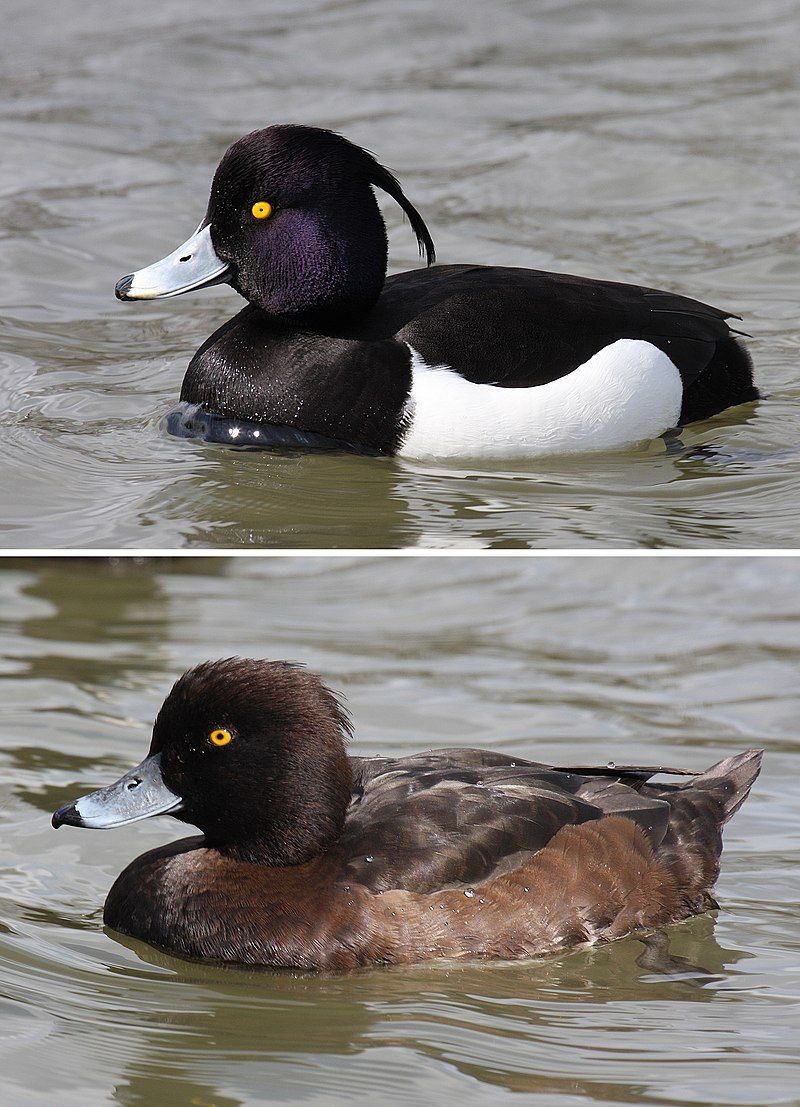
The tufted duck, also known as the tufted pochard, is a small diving duck with a substantial population of around one million birds. It is native to northern Eurasia and has the scientific name of Aythya fuligula.
This scientific name is derived from two sources, the first being the Ancient Greek aithuia, which was an unidentified seabird mentioned by authors such as Hesychius and Aristotle.
The second source is Latin, with fuligo meaning “soot” and gula meaning “throat”.The tufted duck is easily recognizable due to its distinctive head and neck plumage, which consists of a black crown, white cheeks, and a white neck ring.
The head and back are a deep chestnut brown, while the breast and belly are a lighter shade of brown. The wings are dark brown with white specks and the tail feathers are black.
The beak is dark grey and the legs and feet are orange. The tufted duck is a social bird that spends most of its time in small groups but can also be found in large flocks. It feeds mainly on aquatic vegetation, small invertebrates, and seeds.
During the breeding season, the male will perform courtship displays and is very territorial. The female will build a nest lined with downy feathers and lay between 5-8 eggs which will hatch after 25-27 days.
The young ducklings will stay with the female for up to 2 months before becoming independent. The tufted duck is a species of conservation concern, due to its declining population in some areas due to habitat loss, overhunting, and pollution.
Despite this, it remains one of the most common species of duck in Eurasia and is a familiar sight to many birdwatchers.
| Kingdom | Animalia |
| Phylum | Chordata |
| Class | Aves |
| Order | Anseriformes |
| Family | Anatidae |
| Genus | Aythya |
| Species | A. fuligula |
16. Garganey
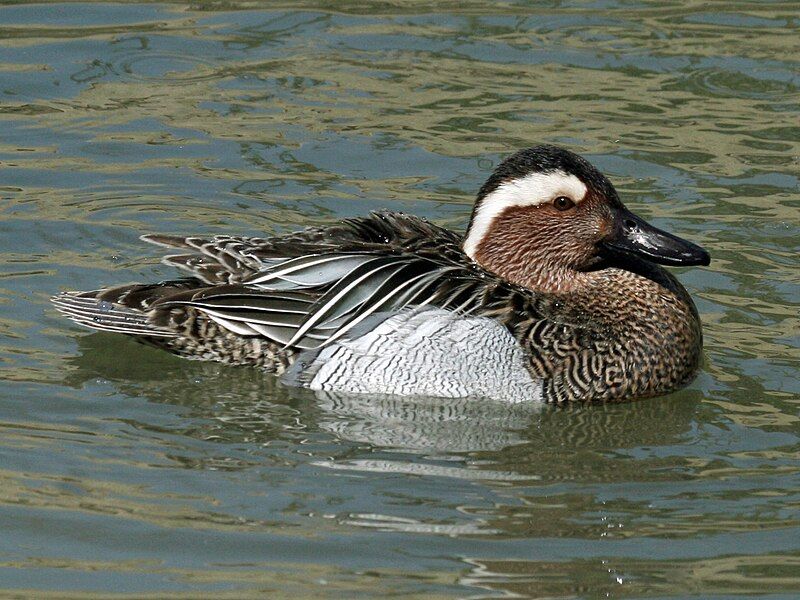
The Garganey is a species of small dabbling duck that is found in a wide range of habitats across Europe and the Palearctic.
This species is strictly migratory, meaning that all of the population moves to warmer climates in the winter when temperatures in northern regions become too cold. During this time, the birds can be found in large flocks in southern Africa, India, Bangladesh, and Australasia.
These wintering grounds provide the perfect conditions for the Garganey, with plenty of food and shelter to help them survive the colder months.
The Garganey is an important species of waterfowl, and the migratory habits of this species helps to ensure its continued survival in the face of a changing global climate.
| Kingdom | Animalia |
| Phylum | Chordata |
| Class | Aves |
| Order | Anseriformes |
| Family | Anatidae |
| Genus | Spatula |
| Species | S. querquedula |
17. Chlamydotis Undulata
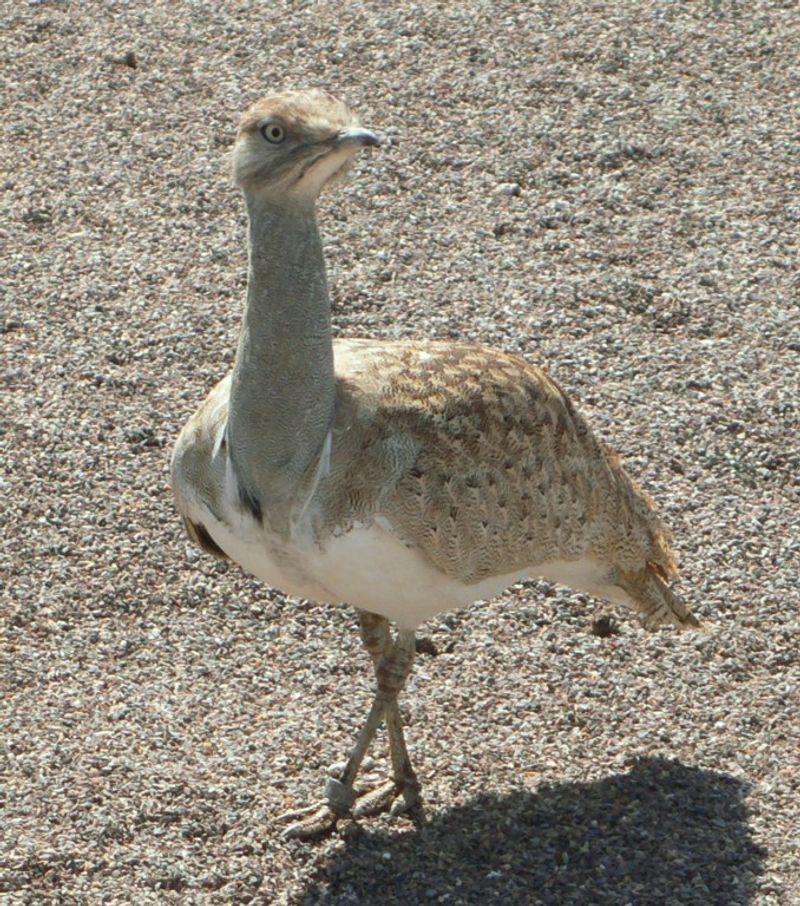
The houbara bustard is a species of bustard native to North Africa, where it inhabits arid habitats. It is classified as Vulnerable on the IUCN Red List, meaning that its global population is at risk of decline due to a variety of factors. This assessment was made in 2014.
In addition, there is a population of houbara bustards in the Canary Islands that has been classified as Near Threatened in 2015. This indicates that this population is at a lower risk than the global population, but still faces a significant threat.
Conservation efforts are needed to ensure the survival of this species, both in North Africa and the Canary Islands.
| Kingdom | Animalia |
| Phylum | Chordata |
| Class | Aves |
| Order | Otidiformes |
| Family | Otididae |
| Genus | Chlamydotis |
| Species | C. undulata |
18. Common Crane
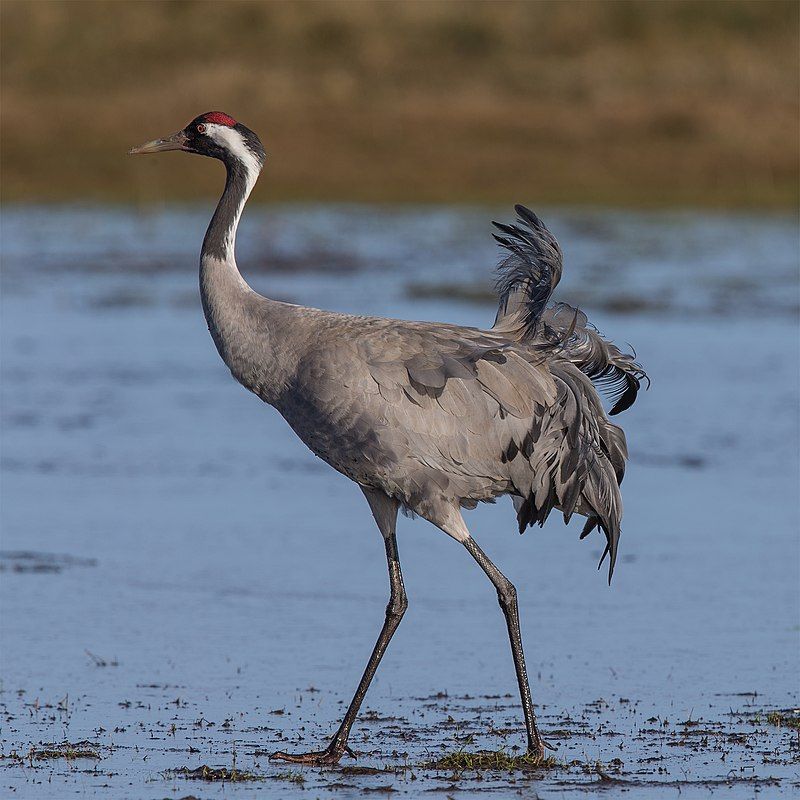
The common crane, also known as the Eurasian crane, is a species belonging to the Gruidae family of cranes. It is a medium-sized bird, making it smaller than the larger species of cranes, but bigger than the smaller species.
The common crane is the only crane species that is commonly found in Europe, with the exception of the Demoiselle crane and the Siberian crane. These two species are only found in the eastern parts of the continent.
The common crane is found across a wide range of habitats in Europe, including wetlands, grasslands, and agricultural areas. It is a migratory species, traveling south during the winter months and returning during the summer.
They feed on insects, small mammals, and other small animals, as well as grains, berries, and other plant material. The common crane is listed as a species of Least Concern by the International Union for Conservation of Nature, as its population appears to be stable.
| Kingdom | Animalia |
| Phylum | Chordata |
| Class | Aves |
| Order | Gruiformes |
| Family | Gruidae |
| Genus | Grus |
| Species | G. grus |
19. Great Crested Grebe
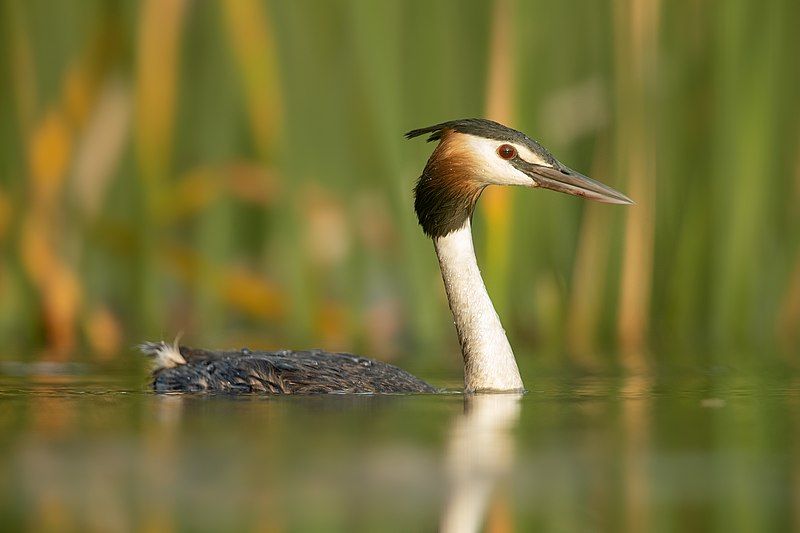
The great crested grebe is a type of water bird that belongs to the grebe family. It is a medium-sized bird with a length of between 33-36 cm and a wingspan of between 68-76 cm.
Its body is mainly a dark greyish-brown color, with a white neck and chest, and a black head and beak. It has long legs and webbed feet, which are adapted for swimming. The great crested grebe is found in freshwater habitats across Europe, Asia, and the Middle East.
It is an excellent swimmer, able to dive up to a depth of 30 meters. It feeds mainly on fish, but also eats other aquatic creatures, such as crustaceans and amphibians. During the breeding season, the great crested grebe engages in an elaborate mating display.
Both males and females take part in the display, which involves the birds swimming in unison with their beaks pointed downwards. The birds also perform a ‘penguin dance’, in which they point their beaks upwards, flap their wings, and nod their heads in unison.
After the display, the birds will form a bond and mate for life. The female lays between two and eight eggs in a nest made of vegetation, and both parents will take turns incubating them.
| Kingdom | Animalia |
| Phylum | Chordata |
| Class | Aves |
| Order | Podicipediformes |
| Family | Podicipedidae |
| Genus | Podiceps |
| Species | P. cristatus |
20. Glossy Ibis
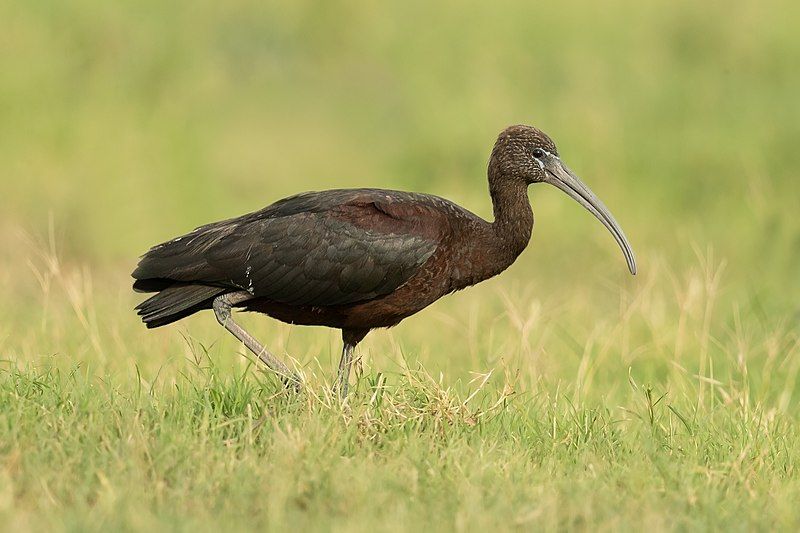
The glossy ibis is a water bird that belongs to the order Pelecaniformes and the ibis and spoonbill family Threskiornithidae. It is a fascinating species of bird that has been given the scientific name of Plegadis falcinellus, which is derived from Ancient Greek and Latin words.
The Greek term “plegados” and the Latin term “falcis” both mean “sickle,” which references the bird’s unique curved bill. This curved bill is used to probe for food in muddy waters and is an important adaptation for the glossy ibis.
It has also been observed that this bird’s bill is able to reach into tight crevices of plants and into the mud to search for its prey. The curved bill also allows the glossy ibis to capture food that is otherwise too small for other species of birds to catch.
This adaptation helps the glossy ibis to thrive in its environment and survive.
| Kingdom | Animalia |
| Phylum | Chordata |
| Class | Aves |
| Order | Pelecaniformes |
| Family | Threskiornithidae |
| Genus | Plegadis |
| Species | P. falcinellus |
21. Wilson’s Storm Petrel
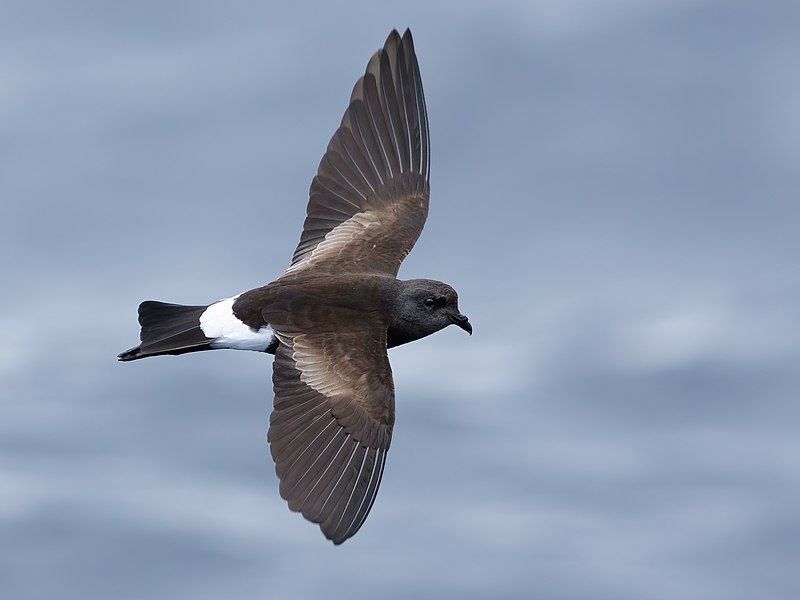
Wilson’s storm petrel is a type of seabird that belongs to the Oceanitidae family. It is a small bird, measuring about 20 cm and weighing up to 65 grams. The bird’s wingspan is approximately 45 cm.
The bird is primarily grey in color, with a white belly, black wings, and a white rump. It has a forked tail and long, slender wings. The Wilson’s storm petrel is found in the Southern Ocean and on some islands of the Antarctic and sub-Antarctic regions.
It prefers to stay near the ocean’s surface, feeding on small fish, squid, krill, and other aquatic organisms. During the day, it is usually seen in flocks, but at night it is known to fly alone.
Wilson’s storm petrel is a migratory species, with some populations staying in the Antarctic region year-round.
It is thought that the bird breeds in the Antarctic and migrates northward to breed in the warmer waters of the North Pacific and North Atlantic. The Wilson storm petrel is a threatened species, and its population is declining due to a number of factors, including overfishing, pollution, and climate change.
It is listed on the IUCN Red List of Threatened Species as Vulnerable. Conservation efforts are underway to protect the bird and its habitat and to ensure its continued survival in the wild.
| Kingdom | Animalia |
| Phylum | Chordata |
| Class | Aves |
| Order | Procellariiformes |
| Family | Oceanitidae |
| Genus | Oceanites |
| Species | O. oceanicus |
22. Ring-necked Duck
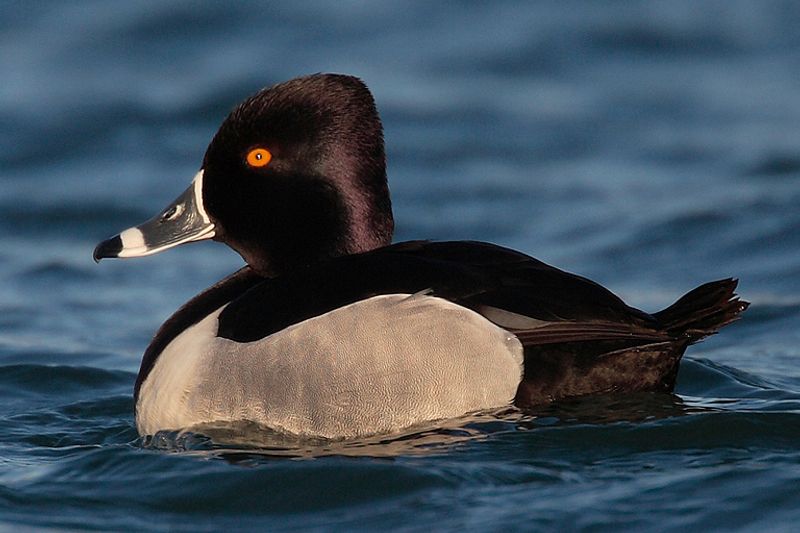
The ring-necked duck is a species of diving duck native to North America. It is a freshwater bird and can usually be spotted in ponds and lakes across the continent.
Its scientific name, Aythya collaris, is derived from two sources: the Greek word aithuia, which was used to refer to an unidentified seabird by ancient writers such as Hesychius and Aristotle, and the Latin word collaris, which translates to “of the neck” and is derived from collum, which means “neck”.
This name is likely a reference to the distinctive white ring around the neck of this species of duck. The ring-necked duck is a beautiful bird that adds a splash of color to freshwater habitats.
| Kingdom | Animalia |
| Phylum | Chordata |
| Class | Aves |
| Order | Anseriformes |
| Family | Anatidae |
| Genus | Aythya |
| Species | A. collaris |
Conclusion
Essaouira is a haven for birds of all kinds, providing a unique and diverse birdwatching experience. Its diverse habitats, abundant resources, and proximity to the Atlantic Ocean make it a great place to observe a variety of species.
Whether you’re a casual observer or a professional birdwatcher, Essaouira is sure to have something to offer.